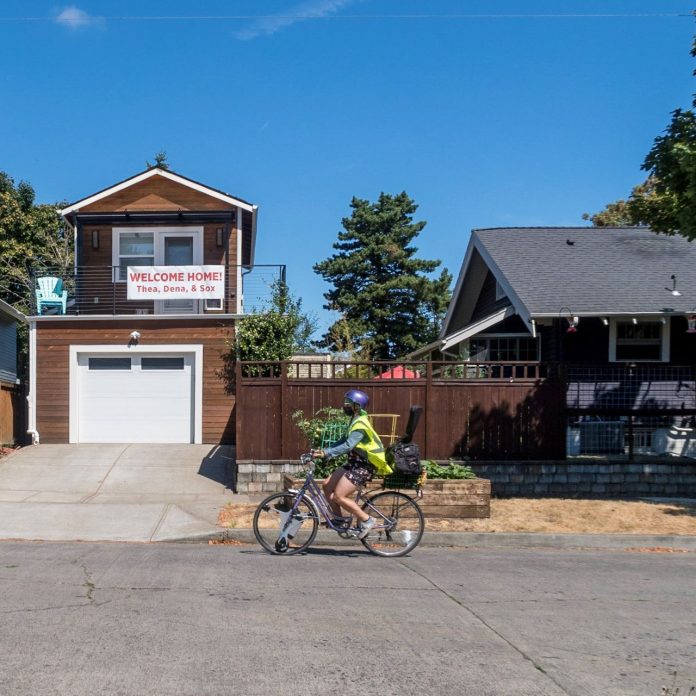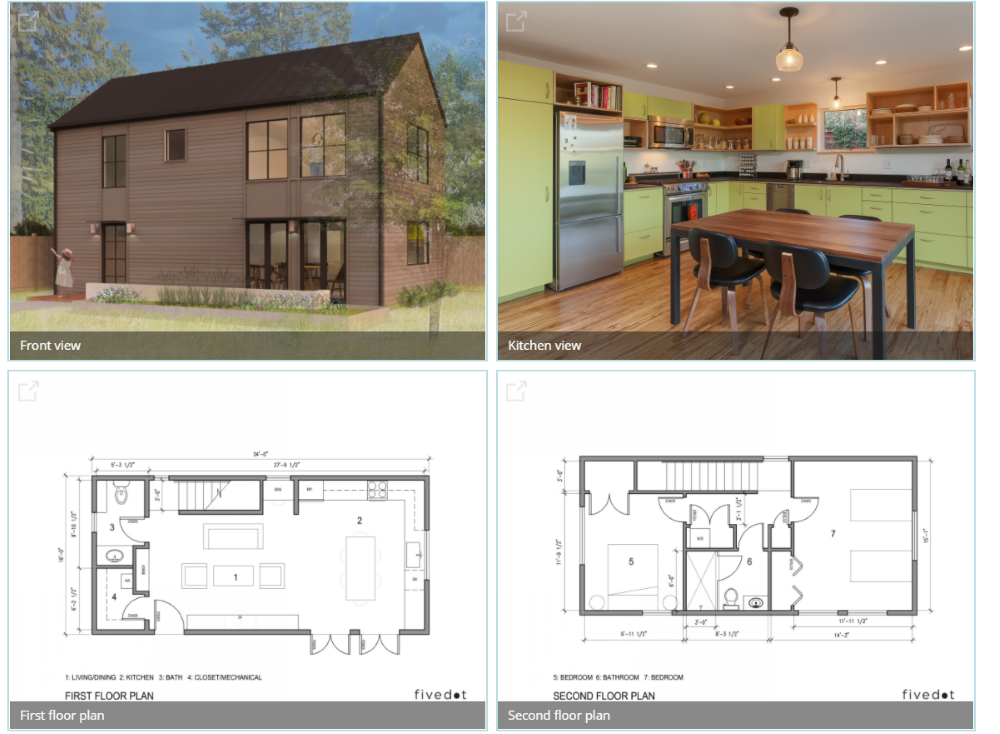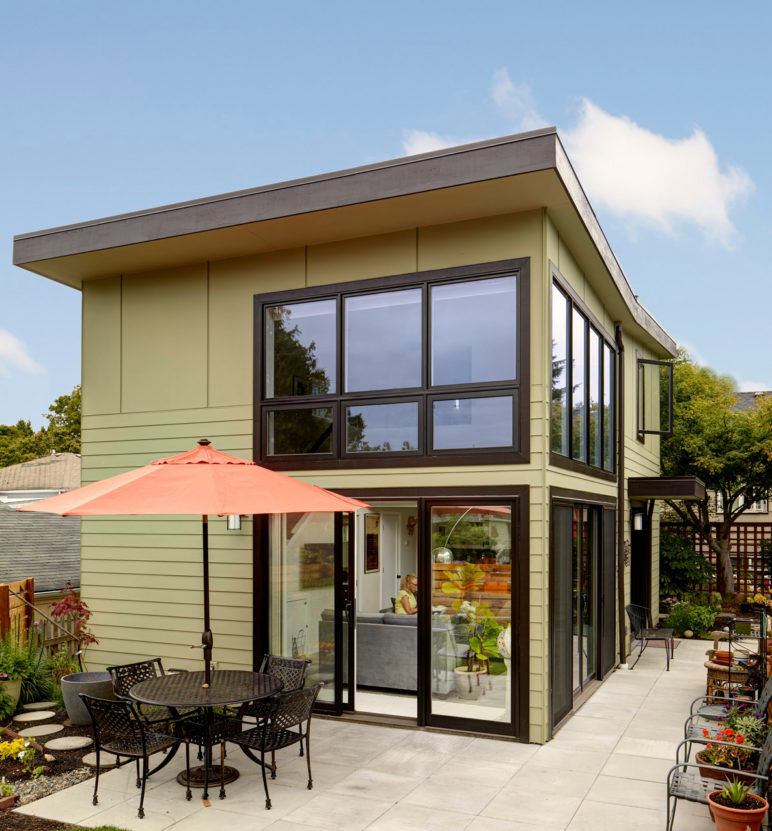
On Monday, Seattle Mayor Bruce Harrell unveiled new legislation to encourage accessory dwelling units (ADUs). This legislation would implement recently passed requirements in state law and take voluntary actions to make it easier to build ADUs across the city. Broadly, the reform aims to allow larger ADUs and streamline regulations to make them feasible for more lots.
The Mayor also announced a forthcoming companion piece of legislation, slated to be released next year that will build upon proposed reforms.
“Making progress on Seattle’s urgent housing affordability needs requires not only increasing overall production, but increasing the diversity of housing available,” Harrell said in a public statement. “ADUs are a key element of our One Seattle Housing Agenda as an efficient, sustainable option to address the housing shortage while also creating new opportunities for first-time homebuyers, multigenerational living, age-friendly housing, and financial stability for homeowners while also preventing displacement.”
Harrell staked a claim to national leadership with his ordinance: “Seattle’s ADU ordinance is one of the most progressive in the country, and this forward-thinking proposal will enhance it to create more flexible living options and inclusive, vibrant communities throughout our city.”
ADUs are categorized in two broad ways in Seattle: attached accessory dwelling units (AADUs), when attached to a principal dwelling unit; and detached accessory dwelling units (DADUs), when located in a separate structure on a lot from the principal dwelling unit. Seattle currently allows ADUs in all zones where single-family dwelling units are permitted, but the regulations diverge by zone and are highly specific in Neighborhood Residential (NR) zones where they are most commonly established.
Brief history of ADU reform
In 2019, the Seattle City Council passed sweeping ADU legislation allowing ADUs on nearly all lots in NR zones, including new allowances for larger DADUs and up to two ADUs per lot. The process to enact the legislation took several years after former Councilmember Mike O’Brien first proposed it in 2016. Appeals by homeowners opposed to more ADUs delayed enactment, but ironically led to broader reforms to ADU regulations than initially contemplated.
Since then, the Washington State Legislature has taken up the mantle in pursuing creation of ADUs statewide in urban areas. That culminated in the latest substantive state laws enacted in 2023 through House Bill 1337, which collectively push cities to further relax local ADU regulations. Seattle has until July 2025 to comply with those laws; the proposed legislation is designed to satisfy those laws and go further in some ways.
The Mayor’s Office has said they’d like to implement the ADU reforms ahead of the deadline to boost housing creation sooner. This is not the approach Harrell has taken to implementing the state’s missing middle requirement, a project which has fallen behind schedule along with the rest of the Seattle Comprehensive Plan. The state requirement for large cities to allow fourplexes citywide and sixplexes near major transit will need to be implemented by July 2025 or the state model code will supersede Seattle’s zoning and implement the standard for them.

Seattle’s 2019 cottage reform has largely been a success, with ADU production up significantly, but the City noted headwinds and a slowing of momentum, pointing to high interest rates.
“A recent analysis from the Office of Planning and Community Development (OPCD) found that the City issued 987 permits for ADUs in 2023, a fourfold increase over 2018 permitting levels,” the Mayor’s office noted. “However, ADU permit applications have fallen this year by nearly 40% compared to the same period in 2023, as interest rates hit a 20-year peak. The new incentives will remove regulatory barriers to help make the construction of ADUs more feasible for homeowners, while remaining consistent with Seattle’s building code, short-term rental code, and tree code.”
The first batch of ADU reforms
The Mayor’s proposed legislation would accomplish the following:
- Two ADUs per lot citywide. Up to two ADUs per principal dwelling unit on a lot would be explicitly allowed. Current provisions allowing two ADUs are specific to Seattle’s NR zones. The state-required reform allows two ADUs per lot in Residential Small Lot (a subtype of NR zones) and Lowrise zones, where currently only one ADU is allowed per principal dwelling unit.
- Combination of ADUs. ADUs would be allowed in any combination, whether two AADUs, one AADU and one DADU, or two DADUs. Current provisions, which allow up to two ADUs per lot in NR zones, do not allow a configuration with two DADUs.
- Boosting living space allowance to 1,000 square feet. The maximum gross floor area for ADUs would be set at 1,000 square feet, with exemptions for any underground floor area, up to 250 square feet for an attached garage, and certain storage areas, and allowance for larger AADUs in structures existing as of July 23, 2023. Current provisions limit ADUs to no more than 650 square feet — with some exceptions — in Lowrise zones.
- Raising height limit to 30 feet or more. The height limit for all ADUs would be raised to the height limit of principal dwelling units in NR zones (generally 30 feet), townhouses and rowhouses in Lowrise zones (generally 30 to 50 feet), 40 feet in all other zones that have a height limit of 40 feet, and 50 feet in all other zones with height limit above 40 feet. On top of this, ADUs would be able to use any applicable rooftop and pitched roof exceptions for additional height. Currently, height limits affect DADUs, limiting them to 14 to 18 feet plus three- to seven-foot roof bonuses in NR zones and 20 feet plus a three-foot pitched roof bonus in Lowrise zones.
- Required yards and setbacks. The rear yards and setbacks for DADUs will be zero feet from alleys and five feet in all other circumstances, with specific exceptions for certain architectural features like eaves and bay windows which may be closer to lot lines. Current regulations are more restrictive in Lowrise zones.
- Conversion of existing accessory structures. In all zones, accessory structures existing as of July 23, 2023 would be eligible to be converted to DADUs even if non-conforming to many development standards, except for height, density, and size limits. The provision further allows for replacement of such structures and additions, provided that any additions conform to development standards. A similar provision currently exists for NR zones, but not in other zones including Lowrise zones.
- Easing lot eligibility for DADUs. Lot eligibility requirements for DADUs, such as minimum lot area and dimensions, would no longer be required in NR zones.
- Waiving location of entry requirements. Prescriptive location of entry standards for ADUs would no longer be required in any zone.
- Eliminating car parking mandates. No car parking would be required for any ADU. This is already current law in NR and Lowrise zones, but the proposed provision would apply in all zones.
- Street improvements. Beyond repair or replacement of public streets necessitated by construction work related to an ADU (e.g., installation of a new sewer line in the street), regular street improvements would not be required in connection to construction of an ADU.
Builders and housing advocates have pointed to high utility hookup fees and other sewer upgrade requirements as a significant barrier to construction of ADUs and other forms of “missing middle” housing that lack the economic scale to weather high regulatory fees. It’s unclear how much relief the street improvements provision can offer, with Seattle Public Utilities and the Seattle Department of Transportation appearing to have a central role in determining how broadly this measure is interpreted and implemented.

Second round of reforms
Next year, the Harrell Administration will release a companion piece of legislation for ADU reform. Details are still relatively high level at this time, but the Mayor outlined four primary objectives for the legislation:
- Encourage more family-sized homes by increasing the maximum ADU size to 1,500 square feet, to promote the creation of more three-bedroom ADUs.
- Simplify ownership paths for ADUs, by reducing the need to establish homeowners’ associations. This presumably means allowing each ADU to exist on its own fee simple lot, which would be created through unit lot subdivisions commonly found in townhouse and rowhouse developments.
- Seek to retain existing homes on lots by allowing additional exceptions to design standards and not counting ADU construction as a substantial alteration.
- Make placement of second ADU on lots easier through alternative building separation and attachment options, such as permitting AADUs when only attached to a principal dwelling unit by breezeways.
While acknowledging the need for family-sized three-bedroom homes, critics have pointed out increasing ADU size would tend to increase prices, decreasing their direct applicability as a solution for working class affordability. As recently as the 1970s, the median size of new primary homes was around 1,500 square feet, but average home sizes have climbed steadily in the decades since, contributing to the housing affordability crisis.
Looking ahead
The Seattle City Council is not expected to take up the first batch of reforms until after the busy fall budget season. The legislation will start in the Land Use Committee, where Chair Tammy Morales has pledged support for the idea.
“This legislation is an important step towards making Seattle a more affordable city. By streamlining the permitting process for ADUs and creating more family-sized, flexible housing options, we are giving homeowners the tools to contribute to a more diverse housing stock,” Morales said in a statement. “I’m happy to bring this legislation forward as Chair of the Land Use Committee so we can expand access to affordable housing, homeownership, and intergenerational living opportunities while growing our toolkit to stem displacement across the City.”
Doug Trumm is publisher of The Urbanist. An Urbanist writer since 2015, he dreams of pedestrian streets, bus lanes, and a mass-timber building spree to end our housing crisis. He graduated from the Evans School of Public Policy and Governance at the University of Washington in 2019. He lives in Seattle's Fremont neighborhood and loves to explore the city by foot and by bike.

